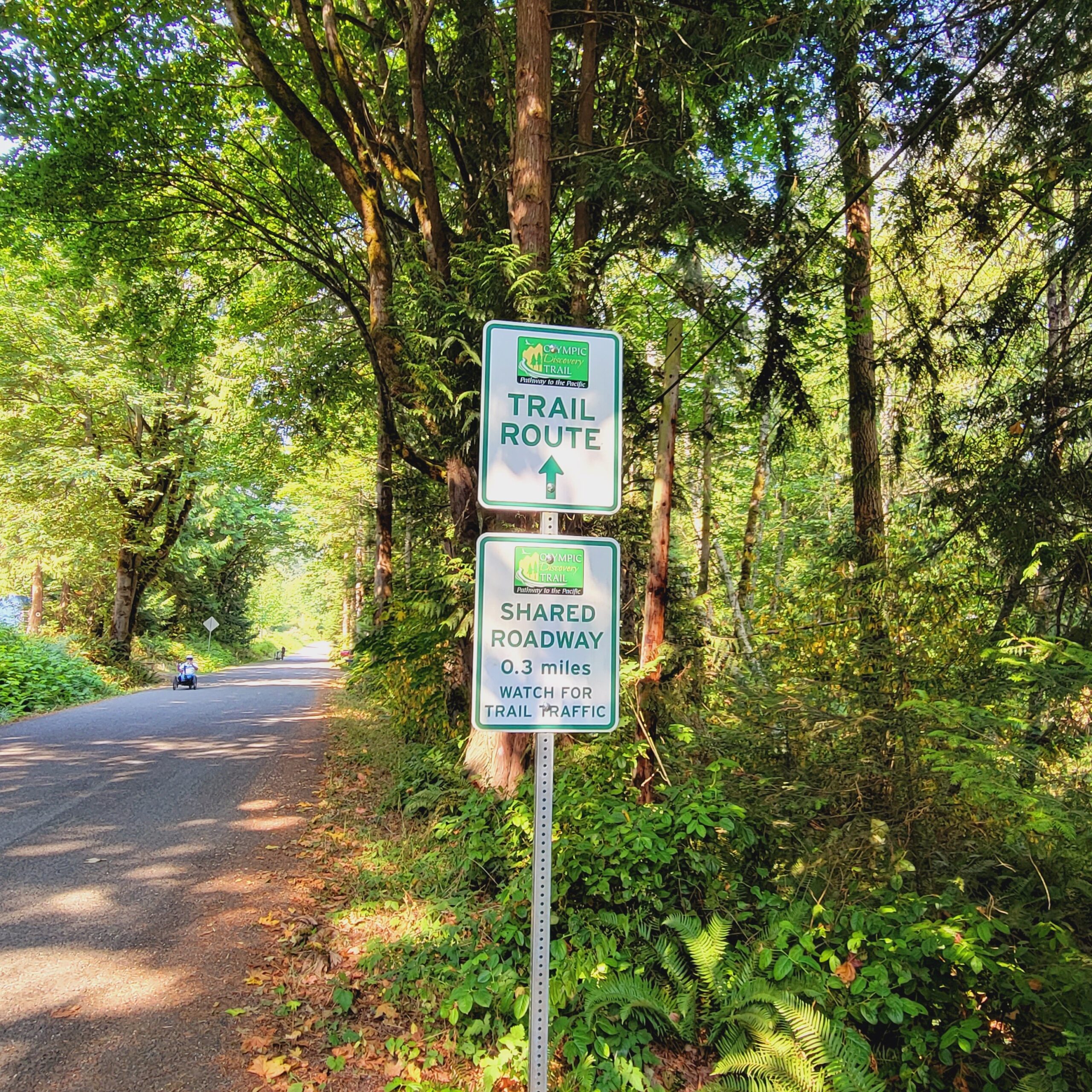Day three: A delightful finale to a thoroughly delightful Sea to Sound ride!
One notable difference between this and many large bike events: There wasn’t any emphasis on finishing quickly, or first, or at all, if that wasn’t within your grasp. On any given climb someone in a chair or on a handcycle might need a push from a volunteer, slowing or stopping others behind them, and it was all fine. I might ride with someone for a while, then one or the other of us would move ahead or drop back. Some might choose to skip a tougher segment, take the shuttle, then go on from the next aid station. We had the chance to chat, refresh and rehydrate every five miles so we had plenty of socializing opportunities. On a beautiful day on a trail through the woods and along the shore, who’s in a hurry anyway?
Riding with people using a variety of wheeled devices gave me more insight into design today. Bike path design over the years has assumed a two-wheeled vehicle ridden by someone with no disabilities. It’s as if the Venn diagram of people with disabilities and people riding bicycles are assumed to be two perfect circles that don’t overlap at all.
Talking to someone who rides a three-wheeler with two wheels in front, pedaled with his hands with occasional help from an e-assist, highlighted the different turning radius that vehicle needs. When engineers consider how to design a road they talk about the typical design vehicle—will a lot of semi trucks move through here every day as a freight corridor, or will a truck only occasionally pass through and it’s mostly a street with personal vehicles? With the proliferation of devices designed to enable more people to get outside and the growing popularity of cargo bikes, family bikes, and tricycles, “design vehicle” thinking for a bike lane or trail needs to start encompassing more than a skinny-tire two-wheeler.
One of the striking features of the Olympic Discovery Trail is the number of beautiful trestles. Both yesterday’s trestles and today’s reinforced my experience in the power wheelchair feeling a real jolt at the gap between the paved surface and boards on a trestle. Several trestles on the ride had a wonderful smooth surface that took nothing away from the experience of being on a trestle and did everything for their accessibility and comfort—another design element that makes the trail better for everyone.
Today’s route took us through the Jamestown S’Klallam Tribe’s lands. They were the first tribe in the nation to be named a Bicycle Friendly Community back in 2015 and we rode past the sign marking their efforts, which include partnering on the Olympic Discovery Trail and promoting bike commuting and cycling in general. Yesterday we rode through the lands of the Lower Elwha Klallam Tribe. These two and the Quileute, Suquamish, and Port Gamble S’Klallam tribes are all partners in the recently awarded 2023 RAISE grant to plan the Puget Sound to Pacific trail network that will include the Olympic Discovery Trail and Sound to Olympics Trail and serve as the western end of the Great American Rail Trail. These partnerships and others are vital to the establishment and maintenance of trails that will serve people for generations to come, and I felt gratitude for those past contributions as I rode on the fruits of their labors today.

I cannot say enough about the level of thoughtful organization that goes into making this ride work for everyone who participates. Today’s route included being shuttled past a stretch of SR20 around Discovery Bay that has no trail and almost no shoulder and thus couldn’t give us the freedom and safety we had every other mile of the ride. (I will note that I saw four bike travelers on that stretch going from Sequim toward Port Townsend so those conditions don’t stop everyone.)
The trail provides so much freedom and safety that I rode helmet-free yesterday and today (and actually most of the first day other than a couple of wet and slippery stretches). The Hierarchy of Controls borrowed from workplace safety places elimination of danger at the top of its inverted pyramid, personal protective equipment at the very bottom as the least effective (it appears as Figure 2-12 in the award-winning Washington State Active Transportation Plan, if you want to go look it up).
Separated trails essentially eliminate exposure to the potential for a deadly crash with a vehicle, except where we crossed a few roads that proved to have zero traffic. This is the freedom everyone deserves: as much freedom as what a driver feels when they pick up a set of car keys knowing they’ll have facilities designed for their use everywhere they want to travel.










Updated to add the Day Three video and photo gallery produced by Jesse Major.











Nice post